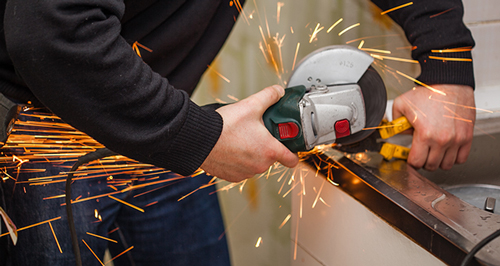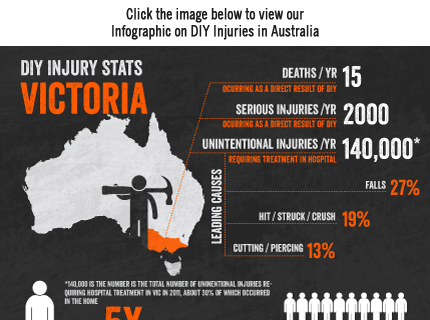Growing Popularity of DIY Causes a Rise in Accidental Injuries

Its that time of year again when ordinary Australians quit their day jobs and take to our television screens to battle it out in the realm of reality television. The most recent trend in reality TV sees contestants trading in laptops and highlighters for hard hats & sledgehammers, all for the chance of having their living rooms remodeled, mortgages paid off, or winning that dream home. So why the sudden interest in ‘Reality Home Renovation’?
In recent years, the high costs & long wait times involved in hiring professional tradespeople has motivated many Aussies to adopt a Do-It-Yourself approach to home maintenance & repair. The availability of low cost tools from family-friendly hardware chains and a wealth of ‘how-to’ resources online has birthed a new generation of youtube educated home handymen, and a dramatic increase in injuries presenting to emergency departments has been the result.
In the past decade, hospital admission rates and emergency department presentations for unintentional injuries have risen 54% and 22% respectively. Patient records show the majority of these injuries occurred not in the workplace, but in the home, implicating DIY as the primary culprit.
So what makes doing this sort of work in the home so much more dangerous than doing it in the workplace? Well for starters, in the workplace employers have a duty of care to their employees. This means workers receive continuous training and are educated on how to use and inspect tools, what PPE to wear and what actions to take in the event of an emergency. OHS officers are always on hand to provide guidance and assistance, and most importantly, ensure compliance with on site safety rules.
In the home, no such conditions exist. Any aspiring home handyman can walk into his local hardware store and purchase an angle grinder – responsible for 20% of all DIY injuries – with no safety training or PPE required. In fact, a 2012 National DIY Safety Survey revealed that 60% of Australians admit they wear no PPE when performing DIY, while 1 in 3 say they have suffered injuries or health problems as a direct result of their DIY endeavours. Deborah Costello, Chief Executive of the Injury Control Council of WA believes too many people are attempting jobs in the home for which they lack the knowledge and skills to execute safely, and that this is putting people at risk.
Hardware Stores
The top excuses survey respondents cited for not wearing PPE were – not realising the risk involved (they’ve never had an accident before, why would they now, confusion over the types of PPE required (many falsely believe that their sunglasses serve as sufficient protection from eye injury), and discomfort. Just as employers have a duty of care to their employees, hardware stores and tool manufacturers have a duty of care to their customers to educate and raise awareness of inherent risks in using the tools they sell, and provide advice on the appropriate PPE required.
Employers
More lost time at work occurs as a result of injuries in the home than from injuries in the actual workplace. As such it is in the employer’s best interest to adopt initiatives that encourage the transfer of safe work practices to the home. Monash University’s DIY Injury Prevention Handbook recommends employers do the following
- Allow tools and personal protective equipment to be borrowed for use at home,
- Offer training if the borrowed tool is not regularly used by the worker,
- Hold safety seminars and provide safety information focusing on ‘off-the-job’ safety
In Victoria, DIY activities account for 12% of off the job adult emergency department visits. Keeping a record of days off work that are the result of DIY Injury can help employers identify the cost to the company and assist in the development of new prevention strategies.
Personal Accountability
DIY-ers also have a duty of care to themselves. Too often it is the risk of getting in trouble or fear of a fine that motivates us to change our behaviour, instead of holding our personal health and safety in high regard. Without the watchful eye of an OHS officer in the workplace, days without incidents would be fewer and further between. If you choose to take on a DIY project in the home, you need to have some personal accountability when choosing tools and performing tasks that could jeopardise your safety and that of those around you.
Tips for a ‘Safety First’ approach to household DIY:
- Get some training – Watching a few episodes of House Rules will not equip you with the knowledge and expertise required to tackle these tasks in real life. If you are really interested in home renovation, enrol in a few DIY courses, talk to a professional, and maybe get a quote before you dive in welding guns blazing.
- Know your limitations – Research the job you are planing before you get started. If the task is out of your comfort zone, consider calling in a professional. Remember, the cost of an injury will often be far more expensive (and painful) than if you’d just hired a tradie to do the job to begin with.
- Recognise the Risks – Some tools and tasks are higher risk than others. Educating yourself on the risks involved and the right controls for injury prevention will go a long toward keeping ten fingers and ten toes attached and in good working order. There are numerous resources online, we have cited a few at the bottom of this article to help get you started.
- Don’t forget your PPE – When you go to the hardware store, don’t just rush to power tools section and forget all about personal protection. A pair of protective gloves or goggles might not feel quiet as exhilarating as purchasing a new power drill, but it’s a far better feeling than having a finger sawn off or undergoing eye surgery.
Many DIY injuries could be prevented if the safe work practices applied and required by law in the workplace were also used in the home. Lowering the rate of DIY injuries moving forward will require a joint effort on the part of tool manufacturers, hardware stores, and employers, to raise awareness of the risks inherent to DIY activities and to educate on the correct PPE to use and safety measures to adopt when undertaking such activities in the home.
Further Reading:
Do-It-Yourself Jobs: Preventing Injury – Information for Workplace Managers
http://www.monash.edu.au/miri/research/reports/other/diyman.pdf
Do-It-Yourself Jobs: Preventing Injury – Information for the Home Handyperson
http://www.monash.edu.au/miri/research/reports/other/diyhome.pdf
Resources:
Report: Unintentional (Accidental) Hospital Treated Injuries – Victoria 2011
http://monash.edu/miri/research/research-areas/home-sport-and-leisure-safety/visu/e-bulletin-edition-9-hospital.pdf
2012 National DIY Safety Survey
http://www.dailytelegraph.com.au/news/nsw/safety-is-not-first-with-diy/story-e6freuzi-1226321659406









































































